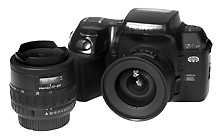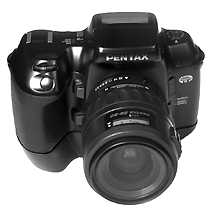

Pentax has concentrated on the amateur market for fifteen years, leaving only the long-running LX manual system model as its professional flagship. Their AF models have not been designed to compete with Nikon or Canon in the pro field. But hark! What of this new Z-1p? Surely it can't be a proper professional camera at just £840 (GB pounds) with a 28-80 zoom? Yes, it can.
However IĠd gladly swap all the PC sockets in the world for the one feature that is unique to Pentax - Hyper Manual mode. In this mode full control of aperture and shutter speed is retained with accurate and easy to read "needle match" indication in both the viewfinder and top plate, but - and here's the best bit - by tapping the IF button, just to the right of your thumb's natural position, the shutter speed is automatically set to the optimum for the set aperture. In use it gives you all the best points of aperture priority, manual and exposure memory lock rolled into one - and it's quicker to use than any of them.
The grip is no more than an expensive (£70 GB pounds!) chunk of metal and plastic and does not add a vertical release or alternative battery compartment like those of most competitors.
Matters are further improved by the ability to adjust fifteen pre-set functions from an audible "in focus" beep (off/on) to the auto-bracketing increments. In addition there is a very useful user mode between "on" and "off" on the main switch which will store your desired choice of exposure, metering and autowind mode - in my case Hyper Manual, spot metering and single frame advance. You can then leave the "on" position set to, say, Hyper Program (shiftable), matrix metering and 4fps and flick between these two modes instantly.
Unusually, there is a solid-looking pop-up flash with a decent guide number (14) and 28mm coverage which is activated by a small stud on the side of the prism. It also charges like lightning - the winder will wait for it to reach full charge but doesn't usually need to bother.
I was initially very suspicious of the off-centre hotshoe but found the LCD atop the prism and elimination of red eye with external flash well worth the quirk.
The autofocus, although quick and accurate, is only single point and noisy by whisper-quiet modern standards, sounding more like Ye Olde Minolta 7000. The matrix metering was a little disappointing with strongly backlit subjects but most would switch to spot metering in those circumstances.
With the Pentax Z1-p and 28-80mm, we also tried two new Pentax optics aimed at the wide angle fanatic - the 20mm f2.8 and the unique 17-28mm Fisheye Zoom f3.5-4.5.

Indeed the Pentax did show some vignetting but only at the very widest aperture - which, of course, manifests itself in dimly-lit corners of the viewfinder, even if a more moderate taking aperture is employed. By f4 illumination was acceptably even across its considerable field. 20mm is a great focal length to work with giving vast depth of field and a wide angle of view without incurring any of the major geometrical distortions that begin to affect anything wider.
Sharpness and image contrast were both up to Pentax's usual high standards. You could argue that with a less frequently used lens such as this, compact size might be more beneficial than full aperture performance.
Below: the Pentax 20mm view (compare this with later pictures from the fisheye zoom)

Considered instead as a variable angle fisheye, its function becomes clearer. Fisheye design sacrifices straight-line geometry for 180 degrees angular coverage. True fisheyes project a 24mm circular image on to the film plane. Needless to say, they are of little use in non-scientific photography.

At its 17mm setting (above) the Pentax is a full-frame 180 degree fisheye, and care must be taken to keep your feet out of the frame. You can photograph the whole of a typical 6'6" door from a distance of about 2ft from the film plane. This often makes lighting or composing fisheye shots difficult. Here's where the 28mm end of the range comes in, providing a fisheye image without the problems of an extremely close viewpoint.

Compare this 20mm setting on the fisheye zoom with the earlier 20mm wide-angle lens image
If the camera is tilted from the vertical a curved horizon will result, but if you keep the horizon central, it can be hard to tell you have not used a conventional lens. At the 28mm setting the view resembles a 24mm lens with extreme barrel distortion.
Sharpness is only marginally less than the prime 20mm and there is a little inevitable vignetting throughout the aperture range. One major disadvantage of the fisheye zoom is that there is no way to use any kind of filter either internally or externally.
Again this a very compact lens meaning that it can be tucked away in the bottom of a camera bag for occasions where that different perspective is required.